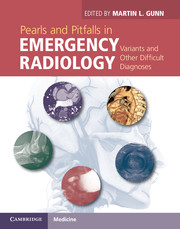Book contents
- Frontmatter
- Contents
- List of contributors
- Preface
- Acknowledgments
- Section 1 Brain, head, and neck
- Section 2 Spine
- Section 3 Thorax
- Section 4 Cardiovascular
- Section 5 Abdomen
- Case 50 Simulated active bleeding
- Case 51 Pseudopneumoperitoneum
- Case 52 Intra-abdominal focal fat infarction: epiploic appendagitis and omental infarction
- Case 53 False-negative and False-positive FAST
- Liver and biliary
- Spleen
- Pancreas
- Bowel
- Case 61 Pseudothickening of the bowel wall
- Case 62 Small bowel transient intussusception
- Case 63 Duodenal diverticulum
- Case 64 Pseudopneumatosis
- Case 65 Pneumatosis intestinalis
- Case 66 Pseudoappendicitis
- Kidney and ureter
- Section 6 Pelvis
- Section 7 Musculoskeletal
- Section 8 Pediatrics
- Index
- References
Case 66 - Pseudoappendicitis
from Bowel
Published online by Cambridge University Press: 05 March 2013
- Frontmatter
- Contents
- List of contributors
- Preface
- Acknowledgments
- Section 1 Brain, head, and neck
- Section 2 Spine
- Section 3 Thorax
- Section 4 Cardiovascular
- Section 5 Abdomen
- Case 50 Simulated active bleeding
- Case 51 Pseudopneumoperitoneum
- Case 52 Intra-abdominal focal fat infarction: epiploic appendagitis and omental infarction
- Case 53 False-negative and False-positive FAST
- Liver and biliary
- Spleen
- Pancreas
- Bowel
- Case 61 Pseudothickening of the bowel wall
- Case 62 Small bowel transient intussusception
- Case 63 Duodenal diverticulum
- Case 64 Pseudopneumatosis
- Case 65 Pneumatosis intestinalis
- Case 66 Pseudoappendicitis
- Kidney and ureter
- Section 6 Pelvis
- Section 7 Musculoskeletal
- Section 8 Pediatrics
- Index
- References
Summary
Imaging description
CT is a highly accurate test for the diagnosis of acute appendicitis, with a sensitivity and specificity of 94% or greater [1–4]. Appendiceal enlargement and periappendiceal inflammation are the most sensitive signs of acute appendicitis.
The maximum diameter of the normal appendix varies widely among patients and ranges from 3 to 11 mm [5]. Various maximum diameter thresholds for the diagnosis of appendicitis with CT have been suggested, the most common being 6 mm. However, 24–45% of the population has an appendiceal diameter greater than 6 mm, making this threshold sensitive, but not specific [5, 6]. Hence, one should not diagnose acute appendicitis based on outer diameter alone. In particular, many normal appendices containing air will have an increased outer–outer wall diameter but non-thickened wall (Figure 66.1).
Airless fluid within an appendix of greater than 6mm outer wall diameter is rarely identified in normal patients, and although this does occur in 1–4% of normal appendices (Figure 66.2), it should raise the suspicion for appendicitis in the symptomatic patient [6, 7]. A “depth” of fluid within the appendix of greater than 2.6mm has been suggested as more sensitive and specific for acute appendicitis by one institution [8, 9].
As the outer diameter of the appendix includes a variable quantity of luminal contents, many have suggested evaluating the mural thickness of the appendix. The mural thickness can be assessed either by measuring it directly in patients with luminal contents or, in patients without appendiceal luminal contents, by measuring the outer wall diameter of the appendix and dividing by two. The average single-wall thickness of the normal appendix on CT is approximately 1.5mm (range, 0.25–3.1mm), and only 0.9–2% of normal patients will have an appendiceal wall thickness of 3mm or more [7, 10].
- Type
- Chapter
- Information
- Pearls and Pitfalls in Emergency RadiologyVariants and Other Difficult Diagnoses, pp. 217 - 221Publisher: Cambridge University PressPrint publication year: 2013

